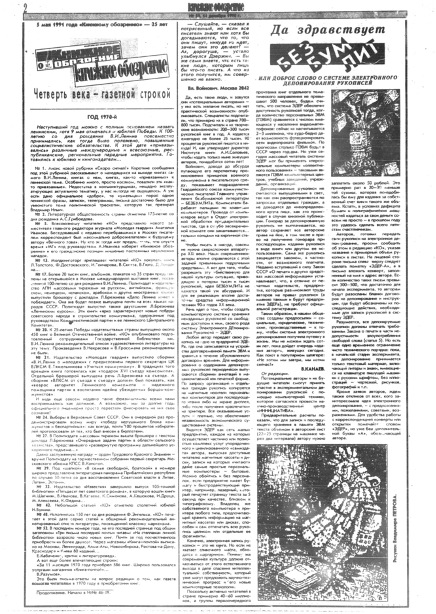Filed Under: Print > Literature > Long Live PaperLessLit
Long Live PaperLessLit

“Da zdravstvyet BezBumLit,” Knizhnoe obozrenie, 14 Dec 1990: 2.
Vladimir Voinovich’s (1932-2018) satire Moscow 2042 (1986) imagined a future Soviet Union in which—among other, even more atrocious developments—literature had gone paperless. Only the ideologically upright would be published; all other writers were essentially writing for themselves. Something similar had been the case in the real Soviet Union of Voinovich’s experience. In his imagined future, the authorities had simply made it official. Instead of writing for the desk drawer for fear of censorship, Voinovich’s fictional writers worked long factory hours and saved paper by never publishing anything.
Four years later, the idea of PaperLessLit (BezBumLit) didn’t seem so crazy to Vladimir Kanaev. It even seemed to offer a utopian solution to a serious problem. Most “potential authors,” he wrote, “have the desire to write, but no practical way of publishing their work. Specialists estimate that there are around 700,000-800,000 such people in the country. They’ve estimated their productivity at around 200,000-300,000 manuscripts per year. And only 25,000 books are published a year. 90% of manuscripts are written for no one!” This tragedy of potential literature could be solved not through some future technology, but via already available computers. Working with the Innovation Center, a new science and technology cooperative, Kanaev created a computerized method of storing the thousands of manuscripts that would otherwise never see the light of day. Writers were invited to write in to hear about the next steps for transferring their manuscripts to an electronic format called EDEM (Electronic DEposit of Manuscripts or EDER, Elektronnoe DEponirovanie Rukopisei, in the original) where they would be stored for posterity.
Although the initiative never got off the ground, the idea stands at the intersection of several important trends in Soviet, post-Soviet, and even world literature. The Soviet Union’s endemic paper shortages made the idea of PaperLessLiterature thinkable, if not unavoidable. Budding computer technology seemed to promise a solution. And the enormity of what Franco Moretti would soon call “the great unread” was transforming from the ideological problem it had been in the Soviet Union (where the best writing had often been underground or written “for the desk drawer”) to the technological problem it would become for the global trend of “distant reading” and algorithmic philology.
In hindsight, it is not so hard to see why EDEM never attracted the mass of potential authors that Kanaev had imagined. However, successors like stihi.ru, proza.ru, and LiveJournal—which used internet technology, and not just electronic deposit, to connect potential authors to potential readers—completely transformed the literary landscape of post-Soviet Russia. The possibilities of PaperLessLit had to be imagined and reimagined several times before they could be realized in practice.
Four years later, the idea of PaperLessLit (BezBumLit) didn’t seem so crazy to Vladimir Kanaev. It even seemed to offer a utopian solution to a serious problem. Most “potential authors,” he wrote, “have the desire to write, but no practical way of publishing their work. Specialists estimate that there are around 700,000-800,000 such people in the country. They’ve estimated their productivity at around 200,000-300,000 manuscripts per year. And only 25,000 books are published a year. 90% of manuscripts are written for no one!” This tragedy of potential literature could be solved not through some future technology, but via already available computers. Working with the Innovation Center, a new science and technology cooperative, Kanaev created a computerized method of storing the thousands of manuscripts that would otherwise never see the light of day. Writers were invited to write in to hear about the next steps for transferring their manuscripts to an electronic format called EDEM (Electronic DEposit of Manuscripts or EDER, Elektronnoe DEponirovanie Rukopisei, in the original) where they would be stored for posterity.
Although the initiative never got off the ground, the idea stands at the intersection of several important trends in Soviet, post-Soviet, and even world literature. The Soviet Union’s endemic paper shortages made the idea of PaperLessLiterature thinkable, if not unavoidable. Budding computer technology seemed to promise a solution. And the enormity of what Franco Moretti would soon call “the great unread” was transforming from the ideological problem it had been in the Soviet Union (where the best writing had often been underground or written “for the desk drawer”) to the technological problem it would become for the global trend of “distant reading” and algorithmic philology.
In hindsight, it is not so hard to see why EDEM never attracted the mass of potential authors that Kanaev had imagined. However, successors like stihi.ru, proza.ru, and LiveJournal—which used internet technology, and not just electronic deposit, to connect potential authors to potential readers—completely transformed the literary landscape of post-Soviet Russia. The possibilities of PaperLessLit had to be imagined and reimagined several times before they could be realized in practice.